名词和代词_教案
- 格式:doc
- 大小:665.00 KB
- 文档页数:22
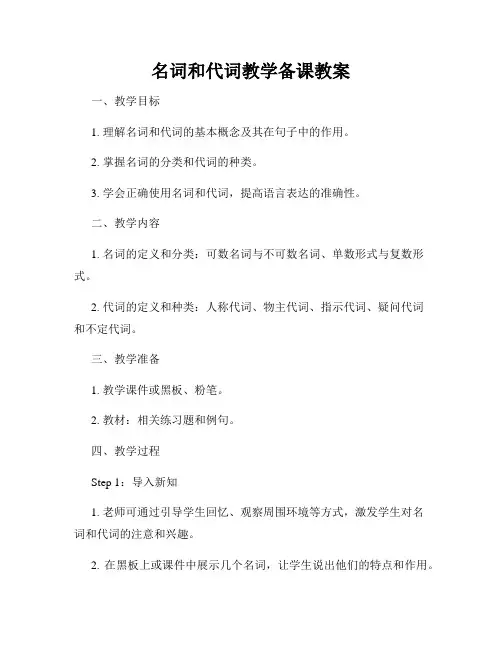
名词和代词教学备课教案一、教学目标1. 理解名词和代词的基本概念及其在句子中的作用。
2. 掌握名词的分类和代词的种类。
3. 学会正确使用名词和代词,提高语言表达的准确性。
二、教学内容1. 名词的定义和分类:可数名词与不可数名词、单数形式与复数形式。
2. 代词的定义和种类:人称代词、物主代词、指示代词、疑问代词和不定代词。
三、教学准备1. 教学课件或黑板、粉笔。
2. 教材:相关练习题和例句。
四、教学过程Step 1:导入新知1. 老师可通过引导学生回忆、观察周围环境等方式,激发学生对名词和代词的注意和兴趣。
2. 在黑板上或课件中展示几个名词,让学生说出他们的特点和作用。
Step 2:讲解名词的定义和分类1. 介绍名词的定义:名词是用来表示人、事物、生物和抽象概念的词。
2. 分类讲解:a) 可数名词与不可数名词:可数名词可以用数字进行数量的计数,而不可数名词则无法计数。
b) 单数形式与复数形式:单数形式表示一个,复数形式表示多个。
Step 3:名词练习1. 将名词分成可数名词和不可数名词两列,请学生在课堂上进行分类,并写出相应的复数形式。
2. 针对可数名词,教师可以列举一些常见的不规则复数形式,如man-men,child-children等。
Step 4:讲解代词的定义和种类1. 介绍代词的定义:代词是用来代替名词在句子中使用的词语。
2. 分类讲解:a) 人称代词:用于代替人的称呼,包括主格和宾格两种形式。
b) 物主代词:用于表示所属关系,包括形容词性和名词性两种形式。
c) 指示代词:用于指示特定的人或物,包括指向性和非指向性两种形式。
d) 疑问代词:用于提问,包括主格和宾格两种形式。
e) 不定代词:用于代指不明确或泛指的事物,包括单数和复数形式。
Step 5:代词练习1. 将代词分类并列出各种代词的例子,让学生在课堂上进行归类和区分。
2. 给学生一些例句,要求他们将其中的名词替换为适当的代词。
Step 6:巩固与拓展1. 分组小练习:老师给出一些句子,让学生在规定时间内尽量用各种名词和代词进行替换,以加深对所学知识的理解和应用。
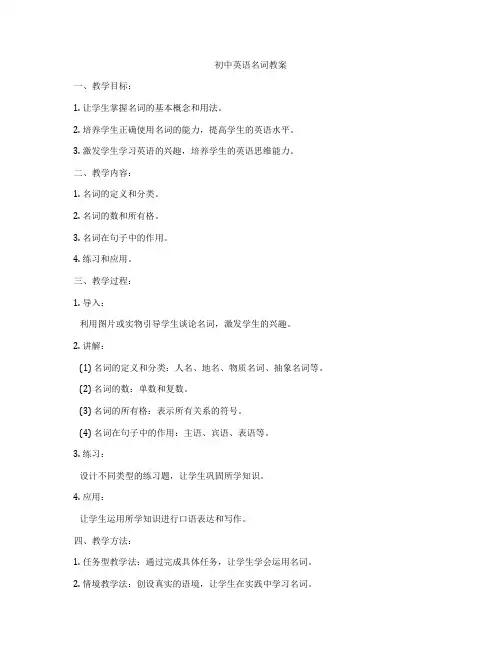
初中英语名词教案一、教学目标:1. 让学生掌握名词的基本概念和用法。
2. 培养学生正确使用名词的能力,提高学生的英语水平。
3. 激发学生学习英语的兴趣,培养学生的英语思维能力。
二、教学内容:1. 名词的定义和分类。
2. 名词的数和所有格。
3. 名词在句子中的作用。
4. 练习和应用。
三、教学过程:1. 导入:利用图片或实物引导学生谈论名词,激发学生的兴趣。
2. 讲解:(1) 名词的定义和分类:人名、地名、物质名词、抽象名词等。
(2) 名词的数:单数和复数。
(3) 名词的所有格:表示所有关系的符号。
(4) 名词在句子中的作用:主语、宾语、表语等。
3. 练习:设计不同类型的练习题,让学生巩固所学知识。
4. 应用:让学生运用所学知识进行口语表达和写作。
四、教学方法:1. 任务型教学法:通过完成具体任务,让学生学会运用名词。
2. 情境教学法:创设真实的语境,让学生在实践中学习名词。
3. 互动式教学法:鼓励学生积极参与,提高学生的学习积极性。
五、教学评价:1. 课堂参与度:观察学生在课堂上的发言和表现。
2. 练习正确率:检查学生完成练习题的正确率。
3. 应用能力:评估学生在口语表达和写作中的运用能力。
六、教学资源:1. 图片或实物:用于引导学生谈论名词。
2. 练习题:用于巩固所学知识。
3. 教学课件:辅助讲解和展示名词的相关知识。
七、教学时间:1课时(40分钟)八、课后作业:1. 复习名词的基本概念和用法。
2. 完成课后练习题。
3. 尝试在日常生活和学习中运用所学知识。
通过本节课的教学,使学生掌握名词的基本概念和用法,提高学生正确使用名词的能力,为后续学习打下基础。
同时,注重培养学生的英语思维能力,激发学生学习英语的兴趣。
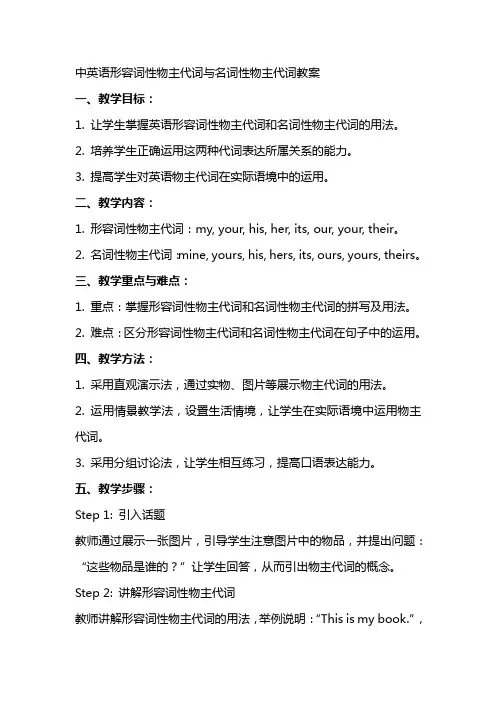
中英语形容词性物主代词与名词性物主代词教案一、教学目标:1. 让学生掌握英语形容词性物主代词和名词性物主代词的用法。
2. 培养学生正确运用这两种代词表达所属关系的能力。
3. 提高学生对英语物主代词在实际语境中的运用。
二、教学内容:1. 形容词性物主代词:my, your, his, her, its, our, your, their。
2. 名词性物主代词:mine, yours, his, hers, its, ours, yours, theirs。
三、教学重点与难点:1. 重点:掌握形容词性物主代词和名词性物主代词的拼写及用法。
2. 难点:区分形容词性物主代词和名词性物主代词在句子中的运用。
四、教学方法:1. 采用直观演示法,通过实物、图片等展示物主代词的用法。
2. 运用情景教学法,设置生活情境,让学生在实际语境中运用物主代词。
3. 采用分组讨论法,让学生相互练习,提高口语表达能力。
五、教学步骤:Step 1: 引入话题教师通过展示一张图片,引导学生注意图片中的物品,并提出问题:“这些物品是谁的?”让学生回答,从而引出物主代词的概念。
Step 2: 讲解形容词性物主代词教师讲解形容词性物主代词的用法,举例说明:“This is my book.”,并让学生跟读,强化记忆。
Step 3: 讲解名词性物主代词教师讲解名词性物主代词的用法,举例说明:“This book is mine.”,并让学生跟读,强化记忆。
Step 4: 区分形容词性物主代词和名词性物主代词教师通过例句对比,让学生区分形容词性物主代词和名词性物主代词的使用场合,如:“Is this your car? Yes, it's mine.”Step 5: 练习教师设置情景,让学生运用形容词性物主代词和名词性物主代词进行对话练习,如:“A: Is this pen yours? B: Yes, it's mine. A: Can I use it? B: Sure, you can use it.”Step 6: 总结与作业教师对本节课的内容进行总结,强调形容词性物主代词和名词性物主代词的用法,并布置作业:用形容词性物主代词和名词性物主代词写一篇小短文,描述自己的房间。
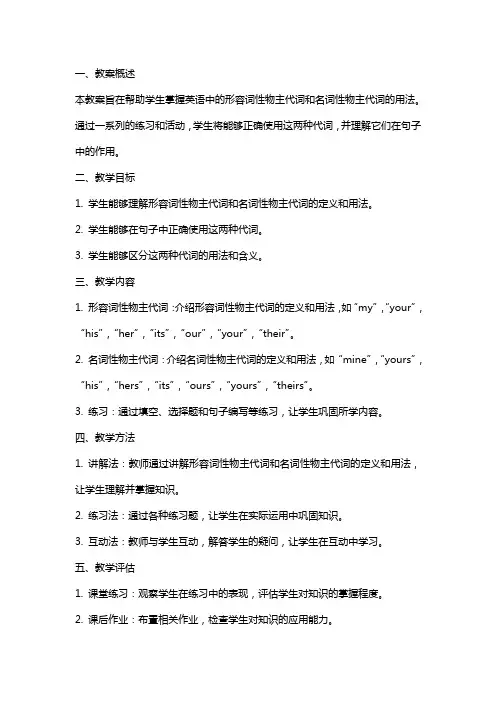
一、教案概述本教案旨在帮助学生掌握英语中的形容词性物主代词和名词性物主代词的用法。
通过一系列的练习和活动,学生将能够正确使用这两种代词,并理解它们在句子中的作用。
二、教学目标1. 学生能够理解形容词性物主代词和名词性物主代词的定义和用法。
2. 学生能够在句子中正确使用这两种代词。
3. 学生能够区分这两种代词的用法和含义。
三、教学内容1. 形容词性物主代词:介绍形容词性物主代词的定义和用法,如“my”,“your”,“his”,“her”,“its”,“our”,“your”,“their”。
2. 名词性物主代词:介绍名词性物主代词的定义和用法,如“mine”,“yours”,“his”,“hers”,“its”,“ours”,“yours”,“theirs”。
3. 练习:通过填空、选择题和句子编写等练习,让学生巩固所学内容。
四、教学方法1. 讲解法:教师通过讲解形容词性物主代词和名词性物主代词的定义和用法,让学生理解并掌握知识。
2. 练习法:通过各种练习题,让学生在实际运用中巩固知识。
3. 互动法:教师与学生互动,解答学生的疑问,让学生在互动中学习。
五、教学评估1. 课堂练习:观察学生在练习中的表现,评估学生对知识的掌握程度。
2. 课后作业:布置相关作业,检查学生对知识的应用能力。
3. 考试:安排期末考试,全面评估学生对形容词性物主代词和名词性物主代词的掌握情况。
六、教学步骤1. 导入:通过展示物品并询问学生它们的归属,引导学生思考物主代词的用法。
2. 讲解形容词性物主代词:教师举例说明形容词性物主代词的用法,如“This is my book.”,并引导学生理解其在句子中的作用。
3. 讲解名词性物主代词:教师举例说明名词性物主代词的用法,如“This book is mine.”,并引导学生理解其在句子中的作用。
4. 对比练习:让学生区分形容词性物主代词和名词性物主代词的用法,如“This is his book.”和“This book is his.”,并解释其区别。
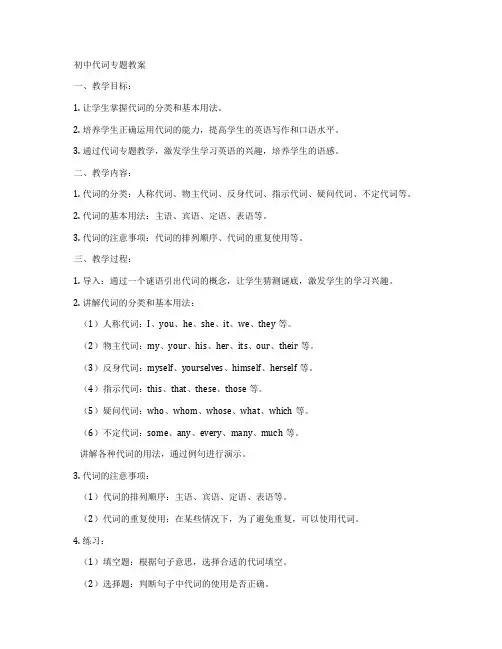
初中代词专题教案一、教学目标:1. 让学生掌握代词的分类和基本用法。
2. 培养学生正确运用代词的能力,提高学生的英语写作和口语水平。
3. 通过代词专题教学,激发学生学习英语的兴趣,培养学生的语感。
二、教学内容:1. 代词的分类:人称代词、物主代词、反身代词、指示代词、疑问代词、不定代词等。
2. 代词的基本用法:主语、宾语、定语、表语等。
3. 代词的注意事项:代词的排列顺序、代词的重复使用等。
三、教学过程:1. 导入:通过一个谜语引出代词的概念,让学生猜测谜底,激发学生的学习兴趣。
2. 讲解代词的分类和基本用法:(1)人称代词:I、you、he、she、it、we、they等。
(2)物主代词:my、your、his、her、its、our、their等。
(3)反身代词:myself、yourselves、himself、herself等。
(4)指示代词:this、that、these、those等。
(5)疑问代词:who、whom、whose、what、which等。
(6)不定代词:some、any、every、many、much等。
讲解各种代词的用法,通过例句进行演示。
3. 代词的注意事项:(1)代词的排列顺序:主语、宾语、定语、表语等。
(2)代词的重复使用:在某些情况下,为了避免重复,可以使用代词。
4. 练习:(1)填空题:根据句子意思,选择合适的代词填空。
(2)选择题:判断句子中代词的使用是否正确。
(3)翻译题:将句子翻译成中文,注意代词的使用。
5. 总结:对本节课的内容进行总结,强调代词的重要性和注意事项。
6. 作业布置:让学生课后复习代词的知识,并结合实例进行练习。
四、教学策略:1. 采用直观、生动的教学手段,如图片、动画等,帮助学生理解代词的概念和用法。
2. 通过例句和练习,让学生充分掌握代词的用法。
3. 组织小组讨论,让学生相互交流、合作,提高学生的口语表达能力。
4. 注重个体差异,给予不同程度的学生个性化的指导和关爱。
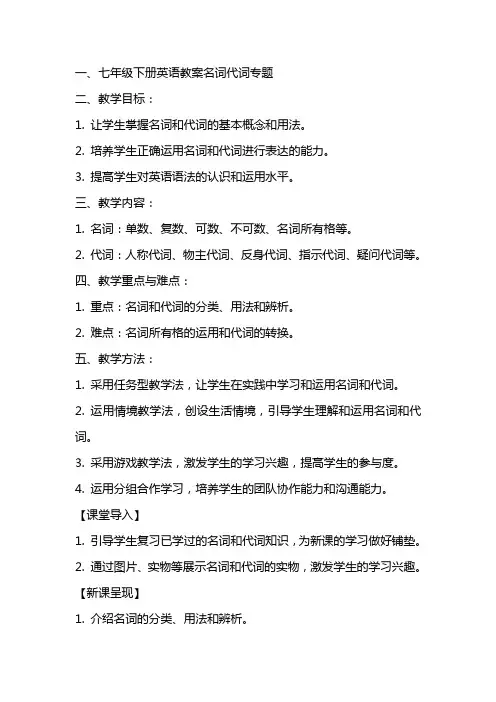
一、七年级下册英语教案名词代词专题二、教学目标:1. 让学生掌握名词和代词的基本概念和用法。
2. 培养学生正确运用名词和代词进行表达的能力。
3. 提高学生对英语语法的认识和运用水平。
三、教学内容:1. 名词:单数、复数、可数、不可数、名词所有格等。
2. 代词:人称代词、物主代词、反身代词、指示代词、疑问代词等。
四、教学重点与难点:1. 重点:名词和代词的分类、用法和辨析。
2. 难点:名词所有格的运用和代词的转换。
五、教学方法:1. 采用任务型教学法,让学生在实践中学习和运用名词和代词。
2. 运用情境教学法,创设生活情境,引导学生理解和运用名词和代词。
3. 采用游戏教学法,激发学生的学习兴趣,提高学生的参与度。
4. 运用分组合作学习,培养学生的团队协作能力和沟通能力。
【课堂导入】1. 引导学生复习已学过的名词和代词知识,为新课的学习做好铺垫。
2. 通过图片、实物等展示名词和代词的实物,激发学生的学习兴趣。
【新课呈现】1. 介绍名词的分类、用法和辨析。
2. 介绍代词的分类、用法和辨析。
3. 通过例句和练习,让学生掌握名词和代词的运用。
【课堂练习】1. 设计相关的练习题,让学生巩固所学知识。
2. 组织学生进行小组讨论,互相纠正错误,提高学习效果。
【课堂小结】1. 对本节课所学内容进行总结,加深学生对名词和代词的理解。
2. 强调名词和代词在实际生活中的运用,提高学生的语言表达能力。
【课后作业】1. 设计课后作业,让学生进一步巩固所学知识。
2. 鼓励学生在生活中运用所学知识,提高英语实践能力。
六、七年级下册英语教案名词代词专题七、教学目标:1. 让学生掌握名词和代词的基本概念和用法。
2. 培养学生正确运用名词和代词进行表达的能力。
3. 提高学生对英语语法的认识和运用水平。
八、教学内容:1. 名词:单数、复数、可数、不可数、名词所有格等。
2. 代词:人称代词、物主代词、反身代词、指示代词、疑问代词等。
九、教学重点与难点:1. 重点:名词和代词的分类、用法和辨析。
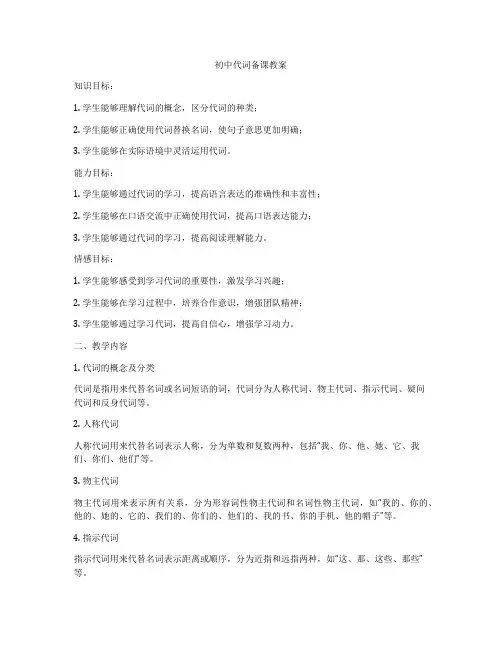
初中代词备课教案知识目标:1. 学生能够理解代词的概念,区分代词的种类;2. 学生能够正确使用代词替换名词,使句子意思更加明确;3. 学生能够在实际语境中灵活运用代词。
能力目标:1. 学生能够通过代词的学习,提高语言表达的准确性和丰富性;2. 学生能够在口语交流中正确使用代词,提高口语表达能力;3. 学生能够通过代词的学习,提高阅读理解能力。
情感目标:1. 学生能够感受到学习代词的重要性,激发学习兴趣;2. 学生能够在学习过程中,培养合作意识,增强团队精神;3. 学生能够通过学习代词,提高自信心,增强学习动力。
二、教学内容1. 代词的概念及分类代词是指用来代替名词或名词短语的词,代词分为人称代词、物主代词、指示代词、疑问代词和反身代词等。
2. 人称代词人称代词用来代替名词表示人称,分为单数和复数两种,包括“我、你、他、她、它、我们、你们、他们”等。
3. 物主代词物主代词用来表示所有关系,分为形容词性物主代词和名词性物主代词,如“我的、你的、他的、她的、它的、我们的、你们的、他们的、我的书、你的手机、他的帽子”等。
4. 指示代词指示代词用来代替名词表示距离或顺序,分为近指和远指两种,如“这、那、这些、那些”等。
5. 疑问代词疑问代词用来构成疑问句,代替名词或名词短语,如“谁、什么、哪儿、哪个、多少”等。
6. 反身代词反身代词用来表示动作的反射或回指主语,如“我、你自己、他自己、她自己、它自己”等。
三、教学过程1. 导入新课通过一个谜语引出代词的概念,让学生猜测谜底,激发学生的学习兴趣。
2. 自主学习让学生自主学习代词的分类,通过查阅课本和资料,了解各类代词的用法。
3. 课堂讲解针对各类代词进行详细讲解,举例说明代词的用法,让学生在课堂上充分理解代词的作用。
4. 互动环节进行代词填空练习,让学生在句子中正确使用代词,增强实际操作能力。
5. 小组讨论让学生分组讨论,总结代词的使用规律,培养学生的合作意识。
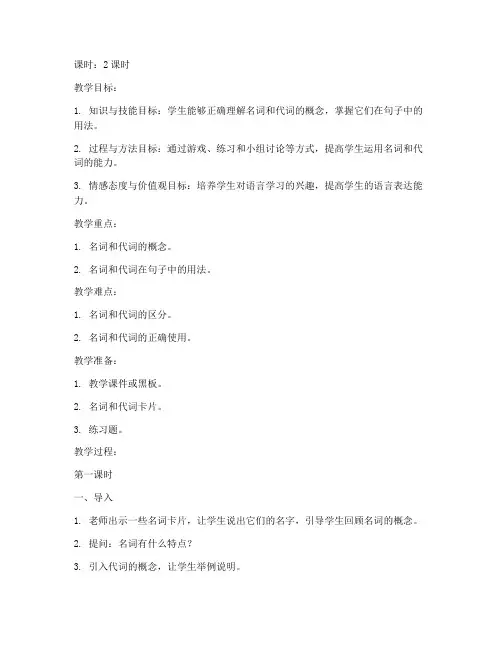
课时:2课时教学目标:1. 知识与技能目标:学生能够正确理解名词和代词的概念,掌握它们在句子中的用法。
2. 过程与方法目标:通过游戏、练习和小组讨论等方式,提高学生运用名词和代词的能力。
3. 情感态度与价值观目标:培养学生对语言学习的兴趣,提高学生的语言表达能力。
教学重点:1. 名词和代词的概念。
2. 名词和代词在句子中的用法。
教学难点:1. 名词和代词的区分。
2. 名词和代词的正确使用。
教学准备:1. 教学课件或黑板。
2. 名词和代词卡片。
3. 练习题。
教学过程:第一课时一、导入1. 老师出示一些名词卡片,让学生说出它们的名字,引导学生回顾名词的概念。
2. 提问:名词有什么特点?3. 引入代词的概念,让学生举例说明。
二、新课讲授1. 讲解名词的分类(如:专有名词、普通名词等)。
2. 通过例子讲解名词在句子中的用法。
3. 讲解代词的分类(如:人称代词、物主代词等)。
4. 通过例子讲解代词在句子中的用法。
三、课堂练习1. 老师出示句子,让学生找出其中的名词和代词。
2. 学生根据所学知识,进行句子填空练习。
四、小结1. 回顾本节课所学内容,强调名词和代词的概念及用法。
2. 布置课后作业,巩固所学知识。
第二课时一、复习1. 老师提问,检查学生对名词和代词的理解。
2. 学生展示自己的练习成果。
二、新课讲授1. 讲解名词和代词的区分方法。
2. 通过例子讲解名词和代词在实际语境中的使用。
三、课堂练习1. 老师出示一些句子,让学生判断其中的名词和代词使用是否正确。
2. 学生进行小组讨论,找出句子中的错误并进行改正。
四、拓展1. 老师出示一些含有名词和代词的段落,让学生朗读并理解段落大意。
2. 学生根据段落内容进行角色扮演,提高口语表达能力。
五、小结1. 回顾本节课所学内容,强调名词和代词的区分及实际运用。
2. 布置课后作业,巩固所学知识。
教学反思:1. 关注学生的学习情况,及时调整教学策略。
2. 通过多种教学手段,激发学生的学习兴趣。
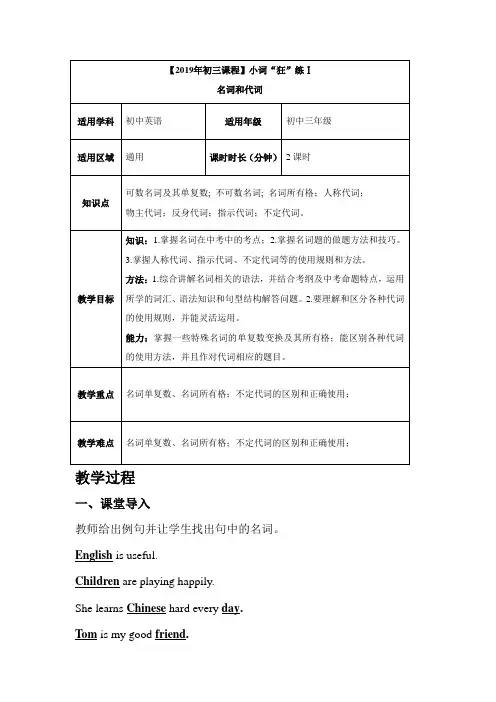
教学过程一、课堂导入教师给出例句并让学生找出句中的名词。
English is useful.Children are playing happily.She learns Chinese hard every day.Tom is my good friend.They chose the boy monitor.导入名词的定义:名词是表示人、事物、地点或抽象概念的名称的词。
二、复习预习1、教师引导学生复习上节课我爱记单词中的重点单词及识记技巧,并采用提问的方式将上节课的重难点进行复习和巩固记忆;2、针对上节课的作业进行订正、讲评、答疑,将集中出错的地方进行分析和进一步讲解。
三、知识讲解考点1:名词分类,可数名词与不可数名词1.名词的种类名词是表示人、事物、地点或抽象概念的名称的词。
它分为普通名词和专有名词两大类。
普通名词分为可数名词分为个体名词和集体名词;不可数名词分为物质名词和抽象名词。
例如:可数名词: a.个体名词man , woman , desk , pencilb.集体名词class , family , police , army不可数名词:a.物质名词meat , rice , cotton , ironb.抽象名词life ,help, happiness , sadness2.可数名词的数1. 规则名词的复数形式:名词的复数形式,一般在单数形式后面加-s 或-es。
现将构成方法与读音规则列表如下:2. 不规则名词复数英语里有些名词的复数形式是不规则的,现归纳如下:不可数名词的认知A、各种物质的统称:bread面包,beer啤酒,cloth布,coffee咖啡cream奶油gold黄金B、抽象名词:advice忠告,beauty美丽,death死亡,experience经验,help帮助,hope希望,information消息/信息,knowledge知识work工作C、有些名词既可以是可数名词也是不可数名词:如:experience指某人的经历时是可数名词,指“经验”时不可数。
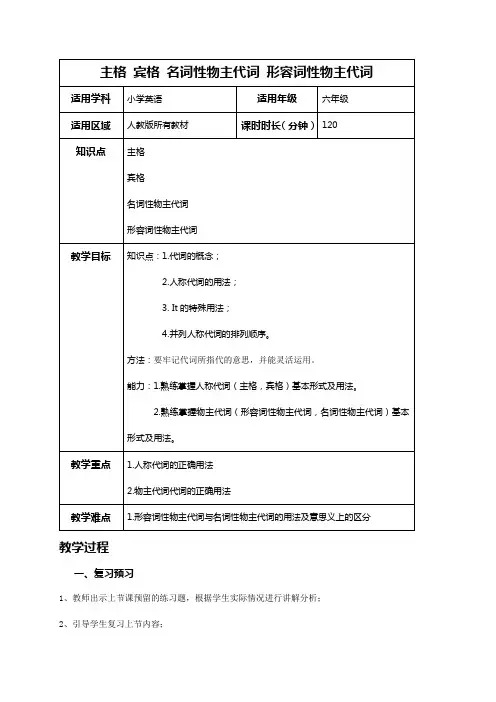
教学过程一、复习预习1、教师出示上节课预留的练习题,根据学生实际情况进行讲解分析;2、引导学生复习上节内容;3、并引入本节课程内容。
二、知识讲解知识点1:代词的概念人称代词是表示我、你、他/她/它、我们、你们和(他/她/它)们的词。
人称代词有人称、格人称代词I无论放在句首、句中或句尾,都要大写.人称代词she除了指女性“她”之外,还可以指祖国、月亮等拟人的东西。
表示一种亲密或爱抚的感情。
知识点2:人称代词的用法一般情况下,人称代词的主格作主语,放在句子的开头.宾格作宾语,通常放在动词,如:let, like, help,give,ask等的后面;或介词,如:for, to, of,at等的后面。
作表语,口语中常用宾格1. 【考查点】人称代词的主格作主语I am a teacher. 我是一名教师。
(I是主语)You are 10 years old. 你10岁了。
(You 是主语)He is my friend. 他是我的朋友。
(He是主语)It is hot today. 今天天气热。
(It是主语)2. 【考查点】宾格作宾语Let’s go .(let’s =let us)Can you help me?你能帮我吗?(me是宾语)The cake is for you. 这个蛋糕是给你的。
(you是宾语)在简短对话中,当人称代词单独使用或用在not后,多用宾格。
---I like English.---Me too.---Who broke the window?---Me.(me作表语= It's me.)Why not me?(为什么不是我?)3. 【考查点】作表语---Who is that?---It's me. 是谁啊?是我。
(me是表语)知识点3:It的特殊用法1. 【考查点】一般情况下,it表示人以外的动物和东西,是单数名词的代词,译为“它”。
如:Where is your car?It is over there.你的小汽车在哪儿?(它)在那边。
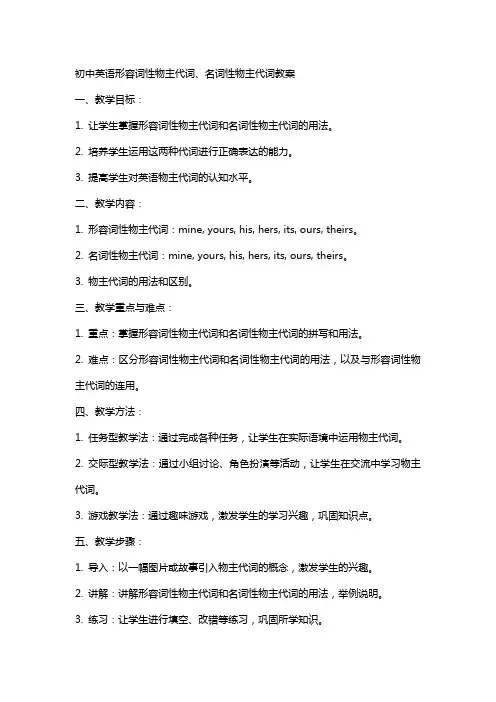
初中英语形容词性物主代词、名词性物主代词教案一、教学目标:1. 让学生掌握形容词性物主代词和名词性物主代词的用法。
2. 培养学生运用这两种代词进行正确表达的能力。
3. 提高学生对英语物主代词的认知水平。
二、教学内容:1. 形容词性物主代词:mine, yours, his, hers, its, ours, theirs。
2. 名词性物主代词:mine, yours, his, hers, its, ours, theirs。
3. 物主代词的用法和区别。
三、教学重点与难点:1. 重点:掌握形容词性物主代词和名词性物主代词的拼写和用法。
2. 难点:区分形容词性物主代词和名词性物主代词的用法,以及与形容词性物主代词的连用。
四、教学方法:1. 任务型教学法:通过完成各种任务,让学生在实际语境中运用物主代词。
2. 交际型教学法:通过小组讨论、角色扮演等活动,让学生在交流中学习物主代词。
3. 游戏教学法:通过趣味游戏,激发学生的学习兴趣,巩固知识点。
五、教学步骤:1. 导入:以一幅图片或故事引入物主代词的概念,激发学生的兴趣。
2. 讲解:讲解形容词性物主代词和名词性物主代词的用法,举例说明。
3. 练习:让学生进行填空、改错等练习,巩固所学知识。
4. 互动:分组进行角色扮演,让学生在实际语境中运用物主代词。
5. 总结:对本节课的内容进行总结,强调重点和难点。
6. 作业:布置相关的练习题,让学生课后巩固所学知识。
六、教学拓展:1. 对比英语物主代词与中文所有格的区别,如“我的”(英语:mine)与“我的”(中文:我的)。
2. 探讨物主代词在特定情境下的用法,如在与朋友、家人、同学之间的交流。
七、课堂活动:1. 制作物主代词的手工制品,如卡片、海报等,增强学生对知识的记忆。
2. 举办物主代词知识竞赛,激发学生的学习兴趣。
八、课后作业:1. 完成课后练习题,巩固所学知识。
2. 结合生活实际,用物主代词写一段话,描述自己的物品或他人的物品。
代词教案 一、分类人称代词 形容词性物主代词名词性 反身代词代词 指示代词 this, that, these,those相互代词疑问代词 who, whom , whose, what, which不定代词二、人称代词、物主代词和反身代词三、指示代词This ,these →近指 That ,those →远指This ,that →指单数; these ,those →指复数注:1、在电话里this 指己方,that 指对方。
如: — Who is that? — This is Kate speaking.2、that ,those 还可以指上文提到的人或物。
This ,these 指下文将要讲到的事物。
格和词性第一人称 第二人称第三人称 功能 单数复数 单数 复数 单数 复数 人称代词主格 I we you you he, she, itthey主和表语 宾格meus you you him, her, itthem 宾和表语 物主代词形容词性 my our your your his, her, itstheir 定语 名词性mineoursyoursyours his, hers, its theirs 主.宾和表语反身代词myself ourselves yourselfyoursel-v eshimself herself itselfthemsel -ves宾、表和同 位语many much few little a few a little很多,许多没有几个,很少(否定)有一些,有几个(肯定)用于可数名词many few a few用于不可数名词much little a littleSome 一般用于肯定句,any 用于否定句,疑问句。
四、典例分析1 These are ___books. Yours are over there.A IB myC meD mine ?〔答案〕B. 〔析〕这里应用形容词性物主代词2 —___is she? — She is a teacher.A WhatB HowC WhoD Where〔答案〕A. 〔析〕这里的四个疑问词放在问句中全都成立,但其意义不同。
代词的教案教案:代词的介绍与练习教学目标:1. 了解代词在句子中的作用和分类。
2. 能够正确使用代词替代名词。
3. 通过练习提高学生使用代词的能力。
教学步骤:1. 导入:通过一个小故事或图片等引入代词的概念,激发学生的学习兴趣。
2. 讲授概念:介绍代词的定义,即代替名词在句子中起到代词的作用。
可举例说明:“Tom is a student. He is smart.” 中的“He”就是代替前面的“Tom”。
3. 分类讲解:根据代词的功能和形式,将代词分为人称代词、物主代词、指示代词、疑问代词、不定代词等,并逐个进行讲解。
可通过对比名词和相应的代词的句子进行说明。
4. 练习:a. 给出一些句子,让学生用合适的代词填空。
b. 给学生一些代词,让他们根据需要构造句子。
c. 在课堂上进行问答游戏,让学生使用代词回答问题。
5. 拓展:如果时间充裕,可以进一步介绍反身代词等相关知识点。
6.总结:对代词的概念和分类进行总结,并强调代词在句子中的作用。
7.作业:布置一些代词相关的作业,如填空练习、改写句子等,巩固所学内容。
教学资源:1. PPT或黑板/白板,用于呈现教学内容。
2. 相关练习题。
教学评估:1. 教师观察学生在课堂练习中的表现,如是否能正确使用代词替代名词。
2. 批改学生的作业,检查他们是否掌握了代词的相关知识和应用。
注意事项:1. 在讲解时要注意讲解的层次,避免过于复杂的内容。
2. 在练习的过程中,老师要及时纠正学生的错误,帮助他们理解和掌握正确的用法。
3. 尽量使用有趣的例子和故事来引入代词的概念,提高学生的学习兴趣和参与度。
中英语形容词性物主代词与名词性物主代词教案一、教学目标:1. 让学生理解并掌握英语形容词性物主代词和名词性物主代词的概念及用法。
2. 培养学生正确运用这两种物主代词进行表达的能力。
3. 提高学生对英语物主代词的辨析能力。
二、教学内容:1. 形容词性物主代词:介绍形容词性物主代词的构成及用法,如“my, your, his, her, its, our, your, their”。
2. 名词性物主代词:介绍名词性物主代词的构成及用法,如“mine, yours, his, hers, its, ours, yours, theirs”。
3. 对比分析两种物主代词的用法和区别。
三、教学重点与难点:1. 教学重点:让学生掌握形容词性物主代词和名词性物主代词的构成、用法及区别。
2. 教学难点:引导学生正确运用两种物主代词进行表达,并辨析其在句子中的作用。
四、教学方法:1. 采用直观演示法,通过实物、图片等展示形容词性物主代词和名词性物主代词的用法。
2. 运用任务型教学法,设计各种练习活动,让学生在实际语境中运用两种物主代词。
3. 采用分组合作学习法,鼓励学生互相交流、讨论,提高团队合作能力。
五、教学步骤:1. 导入新课:通过展示一幅图片,引导学生思考如何用英语表达图中物品的归属。
2. 讲解形容词性物主代词:介绍形容词性物主代词的构成及用法,如“my, your, his, her, its, our, your, their”。
3. 讲解名词性物主代词:介绍名词性物主代词的构成及用法,如“mine, yours, his, hers, its, ours, yours, theirs”。
4. 对比分析两种物主代词的用法和区别。
5. 实践练习:设计各种练习活动,让学生在实际语境中运用两种物主代词。
6. 总结与反馈:对本节课的内容进行总结,并对学生的学习情况进行反馈。
教学评价:通过课堂参与、练习完成情况、小组合作表现等方面评价学生的学习效果。
初中语文名词教案教学目标:1. 让学生掌握名词的定义和基本用法。
2. 培养学生正确使用名词的能力。
3. 提高学生对语文知识的兴趣和积极性。
教学内容:1. 名词的定义和分类。
2. 名词的用法和搭配。
3. 名词的练习和应用。
教学过程:一、导入(5分钟)1. 引导学生回顾已学过的词性知识,如动词、形容词等。
2. 提问:你们知道名词是什么吗?它有什么特点?3. 学生回答,教师总结并板书。
二、讲解名词(15分钟)1. 讲解名词的定义:名词是表示人、事物、地点或抽象概念的词。
2. 讲解名词的分类:人物名词、事物名词、地点名词、抽象名词等。
3. 讲解名词的用法:名词可以作主语、宾语、定语等。
4. 讲解名词的搭配:名词与形容词、动词等的搭配关系。
三、举例讲解(15分钟)1. 举例说明名词的用法和搭配。
2. 分析例句,让学生理解名词在不同语境中的作用。
四、练习(15分钟)1. 布置练习题,让学生填空、改错等。
2. 学生独立完成,教师巡回指导。
3. 集体讲解,纠正错误。
五、课堂小结(5分钟)1. 让学生总结本节课所学的内容。
2. 教师补充并强调重点。
六、作业布置(5分钟)1. 让学生课后复习本节课的内容。
2. 布置作业,巩固所学知识。
教学反思:本节课通过讲解、举例和练习,让学生掌握了名词的定义、分类和用法。
在教学过程中,注意引导学生积极参与,培养学生的动手能力和动脑能力。
同时,通过练习题的设置,让学生在实践中巩固所学知识。
在今后的教学中,要继续加强对名词知识的讲解和练习,提高学生的语文水平。